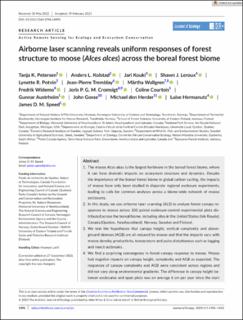| dc.contributor.author | Petersen, Tanja Kofod | |
| dc.contributor.author | Kolstad, Anders Lorentzen | |
| dc.contributor.author | Kouki, Jari | |
| dc.contributor.author | Leroux, Shawn J. | |
| dc.contributor.author | Potvin, Lynette R. | |
| dc.contributor.author | Tremblay, Jean-Pierre | |
| dc.contributor.author | Wallgren, Märtha | |
| dc.contributor.author | Widemo, Fredrik | |
| dc.contributor.author | Cromsigt, Joris P. G. M. | |
| dc.contributor.author | Courtois, Coline | |
| dc.contributor.author | Austrheim, Gunnar | |
| dc.contributor.author | Gosse, John | |
| dc.contributor.author | den Herder, Michael | |
| dc.contributor.author | Hermanutz, Luise | |
| dc.contributor.author | Speed, James David Mervyn | |
| dc.date.accessioned | 2023-10-18T08:15:04Z | |
| dc.date.available | 2023-10-18T08:15:04Z | |
| dc.date.created | 2023-04-12T10:57:16Z | |
| dc.date.issued | 2023 | |
| dc.identifier.citation | Journal of Ecology. 2023, . | en_US |
| dc.identifier.issn | 0022-0477 | |
| dc.identifier.uri | https://hdl.handle.net/11250/3097191 | |
| dc.description.abstract | 1. The moose Alces alces is the largest herbivore in the boreal forest biome, where it can have dramatic impacts on ecosystem structure and dynamics. Despite the importance of the boreal forest biome in global carbon cycling, the impacts of moose have only been studied in disparate regional exclosure experiments, leading to calls for common analyses across a biome-wide network of moose exclosures.
2. In this study, we use airborne laser scanning (ALS) to analyse forest canopy responses to moose across 100 paired exclosure-control experimental plots distributed across the boreal biome, including sites in the United States (Isle Royale), Canada (Quebec, Newfoundland), Norway, Sweden and Finland.
3. We test the hypotheses that canopy height, vertical complexity and above-ground biomass (AGB) are all reduced by moose and that the impacts vary with moose density, productivity, temperature and pulse disturbances such as logging and insect outbreaks.
4. We find a surprising convergence in forest canopy response to moose. Moose had negative impacts on canopy height, complexity and AGB as expected. The responses of canopy complexity and AGB were consistent across regions and did not vary along environmental gradients. The difference in canopy height between exclosures and open plots was on average 6 cm per year since the start of exclosure treatment (±2.1 SD). This rate increased with temperature, but only when moose density was high.
5. The difference in AGB between moose exclosures and open plots was 0.306 Mg ha−1 year−1 (±0.079). In browsed plots, stand AGB was 32% of that in the exclosures, a difference of 2.09 Mg ha−1. The uniform response allows scaling of the estimate to a biome-wide impact of moose of the loss of 448 (±115) Tg per year, or 224 Tg of carbon.
6. Synthesis: Analysis of ALS data from distributed exclosure experiments identified a largely uniform response of forest canopies to moose across regions, facilitating scaling of moose impacts across the whole biome. This is an important step towards incorporating the effect of the largest boreal herbivore on the carbon cycling of one of the world's largest terrestrial biomes. | en_US |
| dc.language.iso | eng | en_US |
| dc.publisher | Wiley | en_US |
| dc.rights | Navngivelse-Ikkekommersiell 4.0 Internasjonal | * |
| dc.rights.uri | http://creativecommons.org/licenses/by-nc/4.0/deed.no | * |
| dc.title | Airborne laser scanning reveals uniform responses of forest structure to moose (Alces alces) across the boreal forest biome | en_US |
| dc.title.alternative | Airborne laser scanning reveals uniform responses of forest structure to moose (Alces alces) across the boreal forest biome | en_US |
| dc.type | Peer reviewed | en_US |
| dc.type | Journal article | en_US |
| dc.description.version | publishedVersion | en_US |
| dc.source.pagenumber | 0 | en_US |
| dc.source.journal | Journal of Ecology | en_US |
| dc.identifier.doi | 10.1111/1365-2745.14093 | |
| dc.identifier.cristin | 2140221 | |
| cristin.ispublished | true | |
| cristin.fulltext | original | |
| cristin.qualitycode | 2 | |

